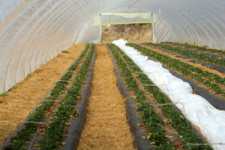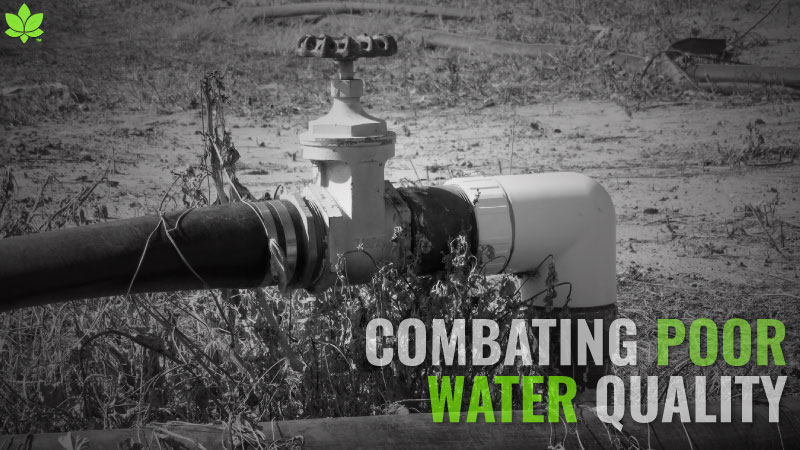

Prior to producing any crop in a high tunnel, growers need to assess the following three areas: marketing, site selection, and pest management.
Marketing
Prior to growing any crop in your new high tunnel, decide what and how you are to market the crop you eventually grow in your high tunnel. Will you be growing a traditional crop (lettuce, tomato, pepper, etc.) or a specialty crop (ginger, apricot, merionberry, kiwano, etc.) for the market?
You also must consider the production costs and what is the return per unit sold. In addition, is your market retail roadside market, farmers market, restaurants, or wholesale? Have you considered consumer demand for the crop you will be growing and the price they are willing to pay? Will you be growing seasonally or 12 months? The answers to these questions must be determined before getting started.
Site Selection
Choose a site for the construction of your high tunnel that has good fertile soils with high organic matter and good drainage. Pick a site with no perennial weeds since these are very difficult to control and thrive in a modified environment like a high tunnel.
Be sure to consider prevailing winds. Constructing the high tunnel length perpendicular to the prevailing winds will help to reduce summer high day temperatures.
Availability of water also should be a priority since the crop will need to be supplied water on weekly basis (several applications of water through drip irrigation tubing) and crops will have to fertilized with soluble fertilizers through an injector.
Pest Management
High tunnel producers benefit from higher ambient temperatures (day/night), reduced evaporative transpiration rates, greater water efficacy and reduced wind stress. The modified environment, which enhances plant production can also attract and sustain similar insect pests that can be found in the field.
Biological pest management using native and released predatory and parasitizing insects has been proven successful for many growers in the last five years. Target pests controlled included: aphid, whitefly, thrip, and spider mites. Successful implementation of biological pest management has relied upon an intensive scouting program, enabling management decisions to be made when the pest population has exceeded economic threshold levels for each crop.
Companion plants have assisted in providing pollen and nectar to adult beneficial insects, thus attracting naturalized species into the production system. Controlling weeds in and around the high tunnel will reduce/eliminate both insect pests and diseases, especially viruses.
Growers interested in producing vegetable crops in high tunnels need to make assessments in three areas before launching a venture. Those areas include marketing, site selection, and pest management.
Marketing
Prior to growing any crop in your new high tunnel, decide what and how you are to market the crop you eventually grow in your high tunnel. Will you be growing a traditional crop (lettuce, tomato, pepper, etc.) or a specialty crop (ginger, apricot, merionberry, kiwano, etc.) for the market?
You also must consider the production costs and what is the return per unit sold. In addition, is your market retail roadside market, farmers market, restaurants, or wholesale? Have you considered consumer demand for the crop you will be growing and the price they are willing to pay? Will you be growing seasonally or 12 months? The answers to these questions must be determined before getting started.
Site Selection
Choose a site for the construction of your high tunnel that has good fertile soils with high organic matter and good drainage. Pick a site with no perennial weeds since these are very difficult to control and thrive in a modified environment like a high tunnel.
A New Biopesticide in the Making To Fight Spotted Wing Drosophila
Be sure to consider prevailing winds. Constructing the high tunnel length perpendicular to the prevailing winds will help to reduce summer high day temperatures.
Availability of water also should be a priority since the crop will need to be supplied water on weekly basis (several applications of water through drip irrigation tubing) and crops will have to fertilized with soluble fertilizers through an injector.
Pest Management
High tunnel producers benefit from higher ambient temperatures (day/night), reduced evaporative transpiration rates, greater water efficacy and reduced wind stress. The modified environment, which enhances plant production can also attract and sustain similar insect pests that can be found in the field.
Biological pest management using native and released predatory and parasitizing insects has been proven successful for many growers in the last five years. Target pests controlled included: aphid, whitefly, thrip, and spider mites. Successful implementation of biological pest management has relied upon an intensive scouting program, enabling management decisions to be made when the pest population has exceeded economic threshold levels for each crop.
Companion plants have assisted in providing pollen and nectar to adult beneficial insects, thus attracting naturalized species into the production system. Controlling weeds in and around the high tunnel will reduce/eliminate both insect pests and diseases, especially viruses.
0
1
5
How To Be Successful Using High Tunnels
Orzolek is a vegetable Extension specialist at the Pennsylvania State University and is a member of American Vegetable Grower's Editorial Advisory Board.
See all author stories here.











